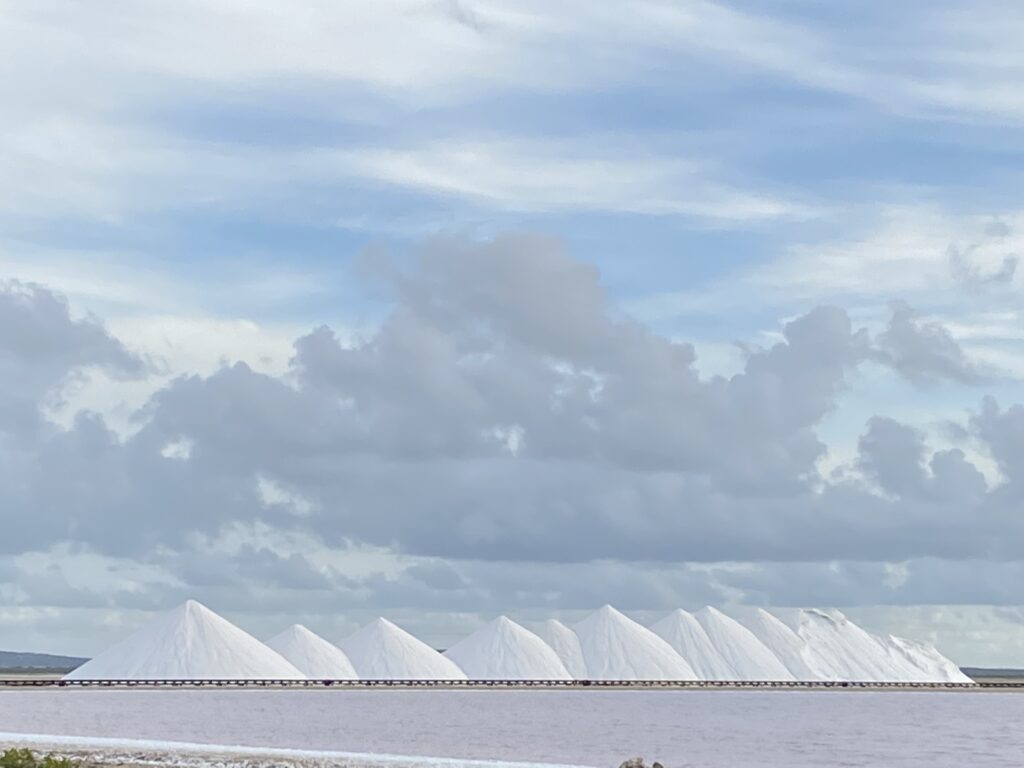
The beautiful island of Bonaire and its salt
Introduction For thousands of years, salt was an important commodity. The word “salary” comes from the word “salt.” Salt was highly valued in ancient times, and its production was legally often restricted. For thousands of years, salt was globally one of the most sought-after products. It was also used as a method of trade and currency. The word “salad” also originated from “salt,” beginning with the early Romans salting greens and vegetables.
1. Without salt no life. These days, salt has a bad reputation. This is because of the quantity modern people consume, not because of the quality. Without salt, important functions of your body eventually stop. Low salt (read “sodium/natrium”) levels in the body can lead to increased resistance to insulin. They can also raise LDL cholesterol levels. Additionally, low salt can cause muscle cramps, nausea, and vomiting. Dizziness, shock, coma, and even death are possible.
2. Hyponatremia (lack of salt) is more common in older adults. They are more likely to take medicines. They may have medical problems that put them at risk for the disorder or they just do not eat enough. However, in general, this is unlikely to happen with the modern Western diet. This diet often includes processed food containing excessive salt. Dining at restaurants that are often generous with salt also contributes to this.
Drinking too much water can be bad for your sodium level. When your urine is completely transparent this is sign that you are drinking too much. Best is if the color of your urine is lightly colored.
If you prepare your own food from fresh ingredients, do not forget to add some salt. I can say from my own experience that I faced a difficult period. This happened when I lived in the Democratic Republic of the Congo (DRC). I regularly felt dizzy to the point of fainting. The cause? A lot of sweating (35 degrees Celsius), sports, and no salt intake. The moment I started to add some salt to my soup, the problems disappeared.
3. First, some clarifications about salt, because it can be a bit confusing. Salt is a compound of two components. These components are sodium (natrium) and chloride. Typically, they are on a 50-50 basis (NaCl). When it comes to weight, sodium (natrium) is 40% and chloride is 60%. So if we talk about 1 gram of salt, this means 400 mg of sodium. It’s important to realize this. The amounts of sodium or salt in recommended minimum and maximum intake are sometimes mixed.
The component we are interested in is sodium, not chloride. It is often referred to as natrium, as this is the Latin name for sodium, from which the symbol “Na” is derived.
4. What happens if your sodium intake is too high? Sodium intake above 2,400 mg per day is linked to high blood pressure. High blood pressure is a risk factor for kidney disease. It also increases the risk of cardiovascular disease, such as heart disease and stroke. The following signs can help you determine if there excessive salt consumption. Look out for bloating, thirst, and frequent urination. You may also experience high blood pressure, swelling, and headaches. Fatigue and palpitations can occur as well.
5. How much salt is healthy per day? The American Heart Association recommends keeping sodium intake under 2,300 milligrams (mg) per day. This is about 6 grams of table salt, or 1 teaspoon. The World Health Organization and the Centers for Disease Control and Prevention also support this recommendation. This includes the salt that’s already in our food. It also includes the salt added during and after cooking. Babies should not have much salt because their kidneys are not fully developed and cannot process it.
The ideal limit is no more than 1,500 mg of sodium per day for most adults. This is equivalent to about 4 grams of table salt or 2/3 of a teaspoon.
Harsh reality. Most Americans consume 8-9 grams of table salt daily (up to 3,600 mg of sodium), which is way too much. Even reducing intake by 1,000 milligrams a day can significantly improve blood pressure and heart health. The best way to reduce salt intake is to eat less processed food and be mindful of your restaurant choices. In other countries the situation is not much different.
6. Minimum intake needed: Is 1 gram of table salt a day enough? An adult body only needs around 1 to 2 grams of salt per day. This is equivalent to 500 to 800 mg of sodium. However, if one lives in tropical countries, more may be needed. How much more, I do not know. Engaging in intensive sports can lead to the loss of several grams of sodium per session. Keep this in mind and discuss your specific circumstances with specialists. My personal health experience in the DRC really taught me a lesson.
For athletes or those engaging in prolonged, intense exercise, it’s crucial to replenish lost fluids and sodium. This helps prevent dehydration. It also avoids electrolyte imbalances, which can be dangerous. Because of this, sports drinks, electrolyte powders, or tablets often contain sodium to help in maintaining balance. They include other electrolytes and are effective during extended exercise bouts.
Earlier, I thought these drinks were not needed, but that is not correct. You can make your own electrolyte drinks. Use water and a few grams of table salt or a combination of sodium and potassium. Cheaper and works as well:).
7. By the way, what are electrolytes? Common electrolytes include salts, acids, and bases. For example, sodium chloride (NaCl) is a salt that, when dissolved in water, dissociates into sodium ions (Na⁺) and chloride ions (Cl⁻), facilitating conductivity. Electrolytes are essential for various bodily functions, such as maintaining fluid balance, transmitting nerve impulses, and enabling muscle contractions.
8. Tip: Include potassium (kalium) in your daily table salt intake
Potassium is important for maintaining healthy blood pressure levels and is found in foods like bananas, potatoes, spinach, and oranges. The World Health Organization (WHO) suggests aiming for around 3,500 to 4,700 mg of potassium per day. Other health agencies support this recommendation.
Brad Stanfield is one of my favorite YouTubers. He explored what would happen if you replaced table salt with a mix of sodium and potassium. Taking this small step can substantially reduce the risk of strokes (by more than 10%). This applies to people older than 60 years old. Stanfield’s conclusions are based on an extensive five-year study in China.
I followed up on his research. I have replaced table salt with a combination of 1/3 sodium and 2/3 potassium (kalium). I am convinced that potassium-enriched salt benefits our health. It cuts the amount of sodium we consume and increases the amount of potassium in our diets. Both steps help to lower blood pressure.
Hope this helps,
Have a great and healthy life,
Robert, your health friend

Flamingos in a salt pan on Bonaire
